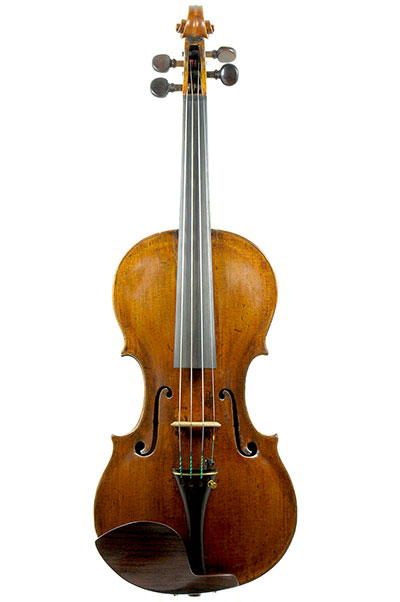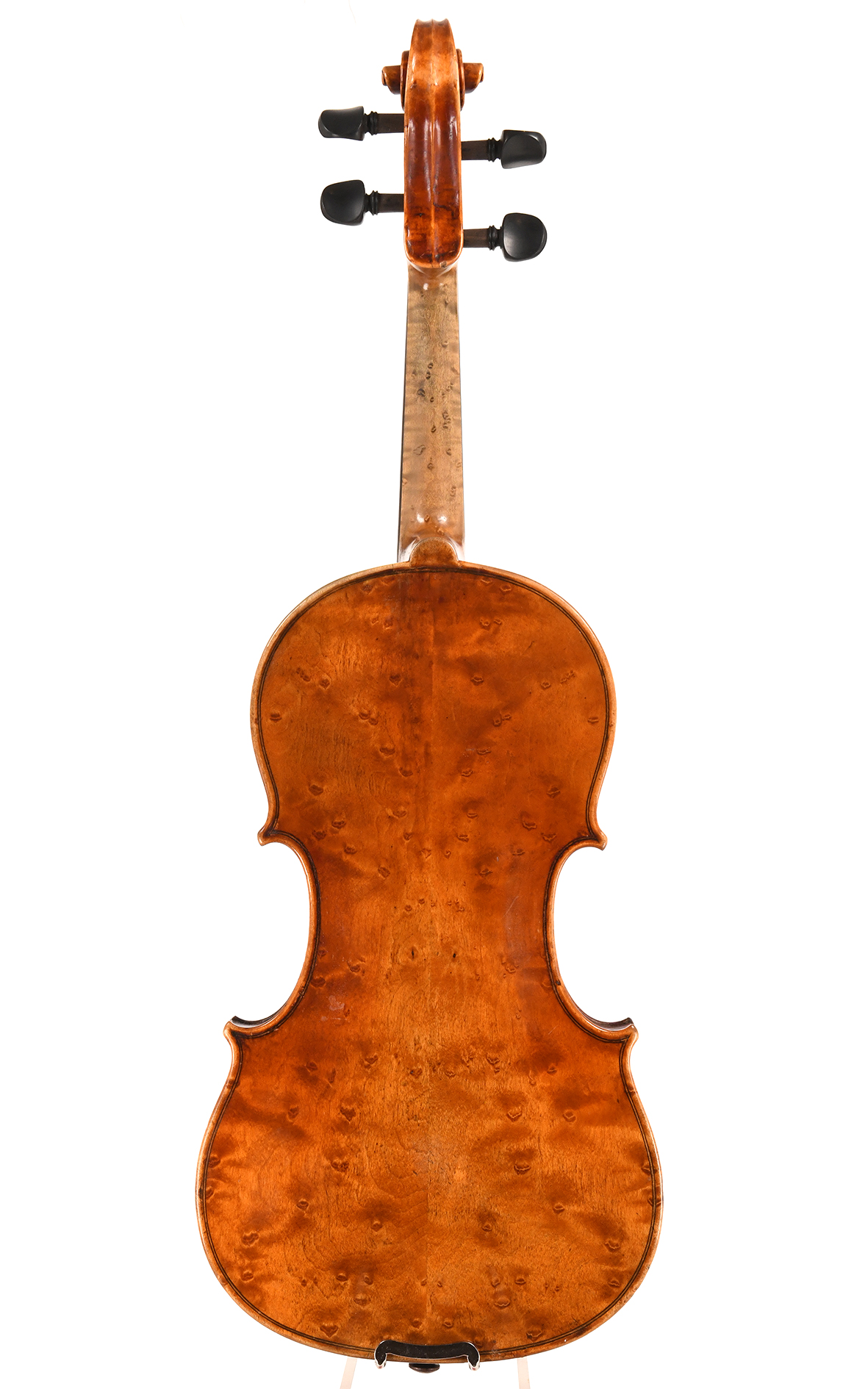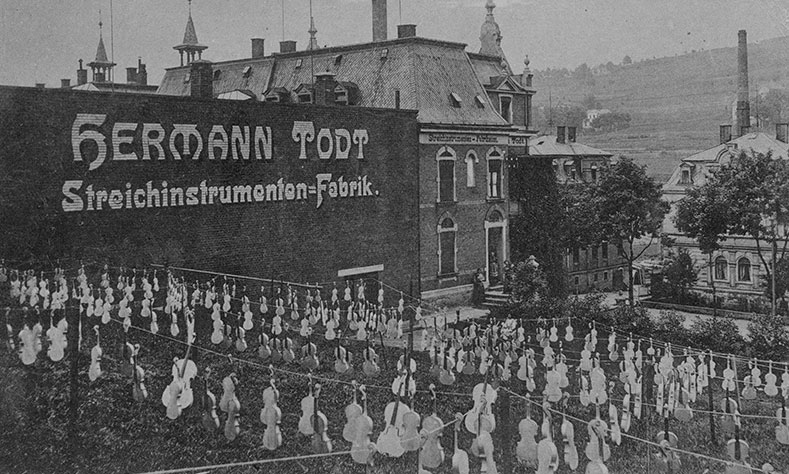Introduction to the history of Markneukirchen violins and German violin making in the Vogtland region, Saxony
Markneukirchen: Violin making between craftsmanship and trade
Markneukirchen is a town in the Saxon Ore Mountains, close to the border with the Czech Republic. For centuries, it was the unofficial capital of the “Saxon-Bohemian Music Corner”, one of the focal points of musical instrument making in Europe. After an enormous industrial boom in the 19th century, violin making in Markneukirchen returned to its artisanal roots and is now represented by small, traditionally oriented workshops, the Markneukirchen Violin Making Museum, which is well worth a visit, and a technical college for musical instrument making.
Markneukirchen violin making overview:
- German violin making in Markneukirchen: the tradition of craftsmanship and globalisation
- Noteworthy families of Markneukirchen violin makers
- Markneukirchen violins
His great sense of regional pride and healthy spirit of self-confidence are what inspired Markneukirchen violin maker Ludwig Gläsel jr. (1842-1931) from Markneukirchen in Germany to print the words “Deutsch-Cremona (German Cremona)” on his violin labels. Ludwig Gläsel jr. was, after all, one of the finest and most successful German master violin maker of his day from the German violin making Vogtland region, and he also made a name for himself with several publications about the history of German violin making. As a member of a well-established and large Markneukirchen family of violin makers, he was certainly entitled to the brash pride that led him to rank violin making in Markneukirchen, the main village of the "Musikwinkel" region (the "musical corner" on the border between Saxony and Bohemia) alongside the legendary name of Cremona.
Or was his label perhaps intended as a sly wink? After all, during the approximately 350 years in which musical instruments were built in Markneukirchen in Germany, the town did not always enjoy an unblemished reputation. Around the mid-1700s, Markneukirchen violin maker Carl Wilhelm Heber saw the need to put an additional label inside one of his Markneukirchen violins:
Many an impostor
Can sneak in here and there
Take heed you read my seal
Or buyer, please beware
Those who deal with old violins are all too familiar with these false labels that claim Italian provenance as well as famous – or at least famous-sounding – names. In the “Musicon Valley,” as Markneukirchen's region is sometimes now called, people understood what was popular and knew that time would tell. There are many Markneukirchen violins that reveal their Saxonian heritage only upon closer examination by the trained eye. The people of Markneukirchen have more than enough reason to be proud of their violin making tradition, however. The history of German violin making in the Vogtland region began in the mid-16th century, and as was the case in the neighbouring town of Klingenthal, Protestant émigrés from nearby Kraslice (Graslitz) in Bohemia brought the art of violin making to Markneukirchen, and with it arose an important new branch of industry.
German violin making in Markneukirchen: the tradition of craftsmanship and globalisation
On 6 March 1677, Duke Moritz von Sachsen confirmed the founding of Markneukirchen's first guild of violin makers, which was established when 12 Bohemian immigrants who had made their homes in the Vogtland region joined forces (cf. Klingenthal – the origins of violin making). To safeguard the quality and integrity of this new community, the guild of Markneukirchen violin makers issued strict rules: applicants had to present sophisticated masterpieces, pay high fees for admission into the guild and find someone who would endorse their application.
 This makes the year 1713 a much more meaningful date, since it was the first time someone "untrained" was accepted: merchant Johann Elias Pfretzschner. Until that time, the masters themselves personally attended markets, fairs and clients, even when great distances were involved. The dawning “professionalisation” of selling violins turned out to be a blessing and curse at the same time. On the one hand, it led to the global success of Vogtland stringed instruments; on the other hand, it brought about the decline of handmade violin making, which gave way more and more to a division of labour, if not to industrialisation.
This makes the year 1713 a much more meaningful date, since it was the first time someone "untrained" was accepted: merchant Johann Elias Pfretzschner. Until that time, the masters themselves personally attended markets, fairs and clients, even when great distances were involved. The dawning “professionalisation” of selling violins turned out to be a blessing and curse at the same time. On the one hand, it led to the global success of Vogtland stringed instruments; on the other hand, it brought about the decline of handmade violin making, which gave way more and more to a division of labour, if not to industrialisation.
In 1719, the Markneukirchen violin making guild had already accepted a craftsman who specialised in peg turning, and shortly thereafter there were separate studios run by neck carvers and makers of violin tops and bottoms. Ultimately countless numbers of people working at home did preparatory work for the few remaining studios of master craftsmen. Labourers often called themselves "factories" and assembled the individual components on behalf of the brokerages that had grown in impressive numbers. These businesses expanded to meet the demands of the globalised market which wanted larger and larger amounts of inexpensive instruments. Around 1800, there were some 80 Markneukirchen businesses working together to produce around 18,000 violins annually. They focussed more and more on the highly sought-after Italian models, turning away from its own Bohemian-Saxonian tradition. A century later, Markneukirchen violin making was highly successful and the town was considered one of the most affluent cites in Germany; it even had its own U.S. consulate general. The dark side of this profit, however, was the great need of the many smaller and financially dependent masters, their families and apprentices.
Noteworthy families of Markneukirchen violin makers
German violin making in the Vogtland region is not to be equated with the large number of cheap instruments that were sold throughout the world in the 18th and 19th centuries. Markneukirchen was the home of – and the venue for training – several international violin makers and violin-making masters who worked in such places as the U.S., Russia and numerous major European cities. Many of those who remained in the Vogtland region, however, also shared the same high standards of quality and solid innovation.
The most important Markneukirchen violin maker families:
Markneukirchen violin maker Heberlein
One of the most prominent families of violin makers in Markneukirchen was the Heberleins, who created a strong international name for themselves. Their most famous member is Heinrich Theodor Heberlein jr. (1843-1910), who was renowned for the excellent quality of his instruments and was awarded multiple honours, including Knight of the Saxonian Albrecht Order. Johann Gottlob Heberlein (1782-1856) was a good violinist and a craftsman who enjoyed experimentation. In 1813 he joined forces with a manufacturer of brass instruments to make a brass violin – an interesting, “interdisciplinary” chapter in the history of Markneukirchen instruments!
Markneukirchen violin making by the Hamm family
Johann Gottfried Hamm (1744-1817) was also part of a large family of Markneukirchen violin makers and was one of the few who was successful with his fake Italian labels. Indeed, his meticulous work, especially his pieces which featured partial inlays with ivory trim, was often incorrectly attributed to Italian schools.
The Roth family of Markneukirchen violin makers
The name of the family Roth stands for producing industrial and yet quality-conscious Markneukirchen violins. Gustav Robert Roth (b. 1852) learned his trade in the famous Leipzig studio of Ludwig Christian August Bausch. In 1873 he founded a factory of stringed instruments and jointly managed it with his son Ernst Heinrich Roth (1877-1948) from 1900 onward. Ernst Heinrich was an outstanding violin maker who perfected his art during his extensive travels through Europe. Another member of the family, violin maker Otto Roth, created a truly unique piece for the opera orchestra in Chicago: a huge bass violin with a body measuring 2.10 m and an overall height of 4.20 m. The Roth company is still operating, and further information about the history of the Roth family can be found on the its website.
Markneukirchen violins: German violins made by violin makers from Markneukirchen
 Markneukirchen violins are made by German violin makers in Markneukirchen. Markneukirchen violin makers possess extensive expertise and a technically understanding of violin, viola, and cello construction. Today, Markneukirchen violins makers blend traditional techniques with innovative approaches to create instruments of exceptional quality. The Corilon online violin shop offers you a curated selection of Markneukirchen violins crafted by renowed Markneukirchen violin makers such as Ernst Heinrich Roth, a German Markneukirchen master violin shown in to the right. Each instrument is distinguished by its characteristic powerful and strong quality tone and flawless German craftsmanship. If you are in search of Markneukirchen violins, Corilon's online catalogue of German violins is worth a visit. The Corilon online violin shop collaborates closely with talented and experienced violin makers from this renowned German violin making town. Discover Corilon's recommendable collection of Markneukirchen violins with the distinctive signature of Markneukirchen violin makers selected for outstanding quality and unique sounds.
Markneukirchen violins are made by German violin makers in Markneukirchen. Markneukirchen violin makers possess extensive expertise and a technically understanding of violin, viola, and cello construction. Today, Markneukirchen violins makers blend traditional techniques with innovative approaches to create instruments of exceptional quality. The Corilon online violin shop offers you a curated selection of Markneukirchen violins crafted by renowed Markneukirchen violin makers such as Ernst Heinrich Roth, a German Markneukirchen master violin shown in to the right. Each instrument is distinguished by its characteristic powerful and strong quality tone and flawless German craftsmanship. If you are in search of Markneukirchen violins, Corilon's online catalogue of German violins is worth a visit. The Corilon online violin shop collaborates closely with talented and experienced violin makers from this renowned German violin making town. Discover Corilon's recommendable collection of Markneukirchen violins with the distinctive signature of Markneukirchen violin makers selected for outstanding quality and unique sounds.
Related articles:
The bow makers of Markneukirchen
Klingenthal: the origin of violin making
Hopf: a dynasty of Vogtland violin makers
H. R. Pfretzschner: bow maker and entrepreneur
Crossing borders: on the history of violin making in western Bohemia
Reference guide: The violin, how to select a violin, its provenance and value
Mittenwald violin makers - contemporary masters
Contemporary violin makers from China and Taiwan
Originally published by Corilon violins.







